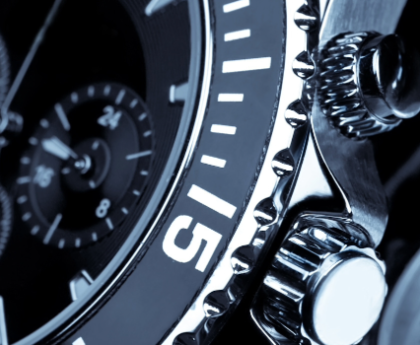This story is from About Time, Esquire’s free newsletter devoted to the watch world, in your inbox every Sunday. Sign up here
Not long ago, someone somewhere sunny on holiday went to photograph their new watch, for a nice bit of social media content.
They arranged it on their hotel balcony, and snapped away.
Then it got knocked off and fell onto the road below, seven storeys down.
That watch in question was a rose gold Richard Mille RM 011, first produced in 2007 with a RRP of £236,000.
“They were doing it for the ‘gram,” notes watchmaker Tom Mason, whose job it was to put it back together. “I think I managed to save about 30 per cent of the original watch.”
The bill came to £35,000.
It’s possible you have no sympathy at all for any aspect of that story. (We all know luxury watch shots are best taken by the infinity pool, right?) But it is illustrative of a business that is keeping Mason pretty busy.
Tom Mason is the sole watchmaker at Ninety, the only authorised pre-owned Richard Mille dealership in Europe and the Middle East.
Richard Mille is known for its unusual watches – it is inspired by the world of F1 and motor racing, with the tagline ‘a racing machine on the wrist’.
The majority of its models come in tonneau-shaped cases with transparent case backs, skeletonised dials and designed from futuristic and unorthodox materials, graphene, carbon and gem-set ceramic, for example, as well as ones the watchmaker has invented itself – Cermet, quartz TPT and metal oxides.
Its designs are certainly not for everyone. If you’re after a simple gold dress watch, you’re in the wrong shop.
Richard Mille watches are also eye-wateringly expensive – starting in the high tens-of-thousands, and levelling out at £1.4m. Although they tend to be marked ‘POA’.
“A lot of people are genuinely offended by the price,” says Mason.
Richard Mille does not sell many watches, for the simple reason it does not need to.
It’s a business model that had made it one of the biggest success stories in watches of the last 20 years.
While other luxury brands’ stock tends to wobble about on the preowned market – the covid pandemic turbocharged demand for many of the most famous Swiss watches; an inevitable crash followed – Richard Mille remains steadfast.
“The preowned market is so uncertain for Rolex, AP, Patek,” says Dean Harding, managing director at Ninety. “But it’s not a big concern for us. RM has been unaffected. It’s stronger than ever, to honest.”
Mason, Harding and myself are talking in the palatial, cool and extraordinary smelling Ninety boutique, in London’s Mayfair. (Opposite, paparazzi are busy snapping away at someone attempting to eat their lunch in the sunshine at a table outside a restaurant.)
Since Richard Mille is a mere child in watch years – its first prototypes were only made in 2000 – and relatively few of its models exist – around 60,000 in total, Rolex makes 1.2m every year – demand has only increased for its pre-owned, discontinued and difficult-to-obtain watches.
Really early editions, such as the RM 02 and RM 03 were made in such tiny numbers, they are now highly sought-after by collectors.
With enough patience (and money) it would eventually be possible to find these on resale sites like Chrono24 and eBay.
But those watches often come without any cast-iron guarantee they are the real deal, and/or have not been tinkered about with by a watch repairer without the correct tools or know-how to service them.
Ninety was established to buy and sell pre-owned RM models, and to restore them back to their original condition. They will also be able to tell whether the watch has been stolen. If you want a rare RM, this is really the only place to come.
And all of it is under Tom Mason’s expert eye.
A former cabinet maker and mechanical engineer, Mason moved into horology in his twenties – his interest in the subject began early, aged four, when his father took him to the Birmingham Clock and Watch Fair, an experience that sounds like a punishment but he claims was “amazing” – before landing a job taking to bits and putting back together some of the world’s most expensive watches.
Down a spiral staircase at Ninety there is his 12 sq ft workshop – a miniscule high-tech universe containing the specialist tools to help guide him through the quantum realm of every RM watch ever made.
Meanwhile, the glass cabinets upstairs contain many ‘never before seen’ historic models – from the RM HJ-01, one of four unique pieces, to the RM 27-10 Tourbillon Rafael Nadal, the second in the RM 027 collection released 11 years before last month’s RM 27-05 Flying Tourbillon Rafael Nadal.
I tried on an a black ceramic RM 57-02 Falcon. Produced in a run of eight, it features the bird of prey hand-painted onto the dial and was, I was told, “aimed at the Middle East market”.
Its owner had enjoyed his time with it, bought it back to Ninety and part-exchanged it for another model. The Falcon could have be mine for £950,000. Yes, I was unclassy enough to ask the price.
The idea of buying back your own watches is a growing one in the business. Rolex recently unveiled its Certified Pre-Owned programme, a way of controlling its own stock and secondary prices, to some extent, and also making sure that its customers stay as happy as possible.
Harding mentions another top-tier Swiss brand who recently came to see Ninety, to sound out how it could do the same thing.
“They wanted to have a look, and we ended up talking for quite a long time about how this works and how we do it,” he says. “It’s something that they’re very keen to do. They had actually agreed a deal with a partner. They were about to sign, and I think they realised they were making a mistake.
“If you’re going to do it properly, the brand needs to take responsibility. Ultimately, nobody will ever be able to tell you more about a particular watch than the brand itself.
About Time: Who are your customers? There’s a huge market for a second-hand Rolexes or Cartiers, or whatever – watches that might cost a few thousand pounds. This is a different kettle of fish.
Tom Mason: We do have a range of clients. There are some people who will only purchase one preloved RM. And then there’s the real serious collectors, and they want an RM 002-V1 [rare serial production model from 2001] or an RM 006 [Tourbillon Felipe Massa model, launched in 2004 in an edition of 25] something incredibly rare, which we didn’t make many of. I’m not in the position to be purchasing a pre-owned Richard Mille. But if I was, I would want to purchase one from the from the brand itself. Knowing the history of the service and everything else. It would be the same if I wanted to buy an old Ferrari F430 and there was one for sale at a random garage, versus from Ferrari themselves.
Brands taking control of the preloved market is becoming more common. Rolex recently started its own Certified Pre-Owned service.
Yes. Certainly, it is about brand protection. It’s really important if you can offer products which have not been messed around with and are maintained in the way that they should be. All brands are catching onto that. They don’t necessarily need to focus primarily on sales. They need to keep an eye on the watches they’ve produced, historically.
Richard Mille watches are especially few and far between.
Yes, absolutely. And the brand is very young in comparison to a lot of others. The mark it has made on the watch industry is quite remarkable. So it would be very foolish to ignore the second-hand market. We really need to be paying attention to it
Which bits of RM models tend to need repairing?
I don’t like to have anything come out of my workshop which shows signs of previous [non-RM] watchmakers, who perhaps who were not as careful as possible. With a lot of the preowned market people don’t want to pay the service costs [that the brand charges], so they will get it done as cheaply as possible, as fast as possible.
It’s a bit mad to take your £350,000 watch into the local jeweller.
Imagine! A lot of it gets done just down the road, in that area of London that I won’t name – where everything sort of gets ‘traded around.’
Hatton Garden.
[Laughs] I will assess and work out what needs be involved in bringing it back to the standard. If something needs to be refinished – so say, a lot of tourbillons, we have components so it’s possible to give it a full refinish and get it back to standard.
You’ll replace the tourbillon?
No. We refinish parts and replace bits, where they need to be. There’s always going to be a balance between conservation and restoration. You don’t necessarily want to take something which is very, very rare and has a really nice patina to it, and make it look brand new. Take the example of an RM 009 [Tourbillon Felipe Massa; 2005]. It has a case which, over time, goes a really beautiful deep grey. And if you refinish that, it becomes very bright and shiny, which is not necessarily a good thing. It’s watch-specific. But we want to make sure that the case is okay, and that there is no sort of visible damage from previous owners. I tend to spare no expense with that. I mean, our own parts are incredibly expensive – inherently. Due to the fact that we just don’t make many of them. My standard is always: ‘What would I be happy with?’
Does anyone balk at their bill?
We don’t see it at RM. If a guy spends £250,000 on a watch and there’s a bill of £10,000 or £12,000 down the road, they’re not going to argue it.
What’s the hardest part to replace?
I haven’t come across anything yet.
You’re not on the phone to Switzerland saying, ‘Find me another double-tilting pinion system!’
Well, inherently the hardest component to replace is always going to be the baseplate of the movement. Because that carries the individual serial numbers. Replacing the baseplate means replacing the movement. Which is not ideal.
What’s the longest you’ve spent on a watch?
That’s a good question. I spent two weeks restoring an RM 002.
That doesn’t sound too bad.
It is for us. I like to work to a certain speed in terms of keeping everybody happy. A couple of weeks for a tourbillon – that’s quite a lot of work in terms of restoration of all the components.
It sounds like you enjoy it.
I really like the process of resorting these pieces. And being able to offer something that people can’t buy from the boutique. I’m sure you can tell.
Do you get ‘demanding’ customers?
Yes. Obviously, it’s hugely frustrating if you have a watch in for service somewhere, and, you know – you just want it back. And someone’s telling you that it’s going to be a silly amount of time. So we can have people who perhaps don’t understand the level of intricacy of the work. But the majority of people are very understanding.
Have you ever rejected a watch for being too battered?
That’s… a tricky question. We try not to. But, you know, there’s always going to be occasions when watches are not going to be suitable for our high standards.
Part of the RM brand is that they’re sold on their toughness. Nadal bashing a tennis ball about on Centre Court wearing one, for example.
The biggest damager of watches is them being sold on the grey market. Generally, somebody wearing an RM, they’re built very well, and they will stand up to the point it can always be restored or be brought back. But serious damage to the movement is another story.
If you’ve spent that amount of money on a watch, you’d like to hope the owner has taken some care of it.
Where the damage gets done is people reselling them. It’s a tremendous problem. What all brands call ‘third-party intervention’ is an issue. Especially if they’ve been modified and they have fake components in them. It becomes quite problematic.
A thing you hear with the top vintage Rolex dealers these days is that the cases should be unpolished – ie: not buffed-up, to appear new.
Each watch we get is always going to be a judgement call, which is done by myself or the directors. For example, if we had an RM 001 [from 2001] it would be a very, very difficult judgment call as to whether to give it a full polish – there’s only 17 of them in the world. It’s a dilemma: conservation versus restoration. Do you want to conserve the watch in its original state, or do you want to make it absolutely beautiful for a sale? I think people understand that for an incredibly rare watch like that the most adventitious thing to do is not always to make it look brand-new. But if we were to take a titanium RM 010 [from 2006] – for example – which is… I don’t want to use the term entry-level…
It costs over £100,000.
High entry-level is one way of saying it! Selling something like that – the standard client will really want a piece that looks like new. And under those circumstances we can polish the case – we can use exactly the same techniques as they do in the factory in Switzerland and we can restore it like a new case. So yes – I agree with you in terms of the guys who have Rolexes – say you have a beautiful 6265 or a 6263 [Daytonas] or a 5153 [Patek Philippe Calatrava] – any of those lovely old watches – the collectors are always going to covet one that hasn’t had metal removed [by polishing]. And I think that comes down to rarity. People wanting things as in original condition as possible – original bracelet, original hands. As [Richard Mille] gets older that balance will tip further and further towards that conservation. In another 20 years or so we will perhaps look at it in a different point of view.
How good at judging your customers are you? Can you predict the state of a watch when the person walks through the door?
I don’t know if I’m that good at psychology. I do play a lot of poker. The watch generally does the talking. A mark one eyeball, and a loupe – and just assess it.
Do you have a waiting list?
We certainly do. We have clients who want specific models. They go incredibly fast. And we will maintain contact with the clients that have wish-lists – with regards to getting that sorted for them.
You must have preferred customers?
You always need to maintain good relationships with clients. That’s industry wide. But we’re very friendly in terms of establishing new relationships with clients who want to get into RM and get their names in the RM network. Which may not be possible though the [brand[ boutiques.
Has anyone asked for last year’s Ferrari collab?
The ‘Ferrari’ – the UP-01 [£1.4m credit card-sized project with the car manufacturer] is mind-blowing to me. As a watchmaker and an engineer, it’s just… how they manage to do that is another level of wizardry. Every time I look at one of those I think ‘How did they do this?’ But I’d say the majority of the pieces that are very hot tend to be the more traditional Richard Mille style.
Such as?
The current model RM 72-01 [from 2020] is very popular. We have a lot of people requesting things like the baby Nadals [RM 035; 2011] the Bubba watches, the RM 055s [inspired by the golfer Bubba Watson; 2012], they’re always incredibly popular.
What do you make of the brand’s success over the last few years? It’s gone fairly bonkers.
It’s been incredible to watch. They’re always going for the next amazing material. There’s even models with unique case materials – I don’t think the material for the RM 27-04 [from 2020] has been used on anything else [‘TitaCarb’, a polyamide reinforced with up to 38.5% carbon fibre, produced exclusively for RM]. They’re always trying something new. And it’s always something which is really bloody hard to work with.
This story is from About Time, Esquire’s free newsletter devoted to the watch world, in your inbox every Sunday. Sign up here
Johnny Davis is the Style Director of Esquire. He was previously editor of the influential British magazine The Face.








